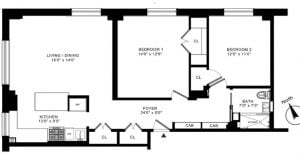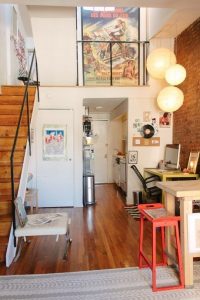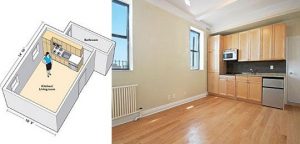Co-op Square Footage in NYC
Go Back To Previous Page New York City has a strong sense of co-op culture. It’s a culture that naturally came about as a part of this living situation for over 100 years. Knowing your home’s total square footage is one of the most significant parts of a co-op life. Though most owners boast, your square footage isn’t just for bragging rights. It tells you a lot about your monthly expenses, your rights as a tenant, and more. Why don’t co-ops list square footage? What is the average square footage for a co-op building? How do you calculate the square footage for a Co-op? Why don’t co-ops list square footage? For buyers, sellers, and brokers, co-op measurements in NYC are very controversial. Indeed, most co-op apartments for sale do not have official square footage figures listed in the building’s original offering plan. Furthermore, there is a multitude of ways to measure square footage.
New York City has a strong sense of co-op culture. It’s a culture that naturally came about as a part of this living situation for over 100 years. Knowing your home’s total square footage is one of the most significant parts of a co-op life. Though most owners boast, your square footage isn’t just for bragging rights. It tells you a lot about your monthly expenses, your rights as a tenant, and more. Why don’t co-ops list square footage? What is the average square footage for a co-op building? How do you calculate the square footage for a Co-op? Why don’t co-ops list square footage? For buyers, sellers, and brokers, co-op measurements in NYC are very controversial. Indeed, most co-op apartments for sale do not have official square footage figures listed in the building’s original offering plan. Furthermore, there is a multitude of ways to measure square footage.
How do you calculate square footage? For example, one can estimate from interior-to-interior walls, exterior-to-exterior walls, interior-to-exterior walls, or some combination of these methods.
Why Don’t Agents Always Mention Square Footage In Co-ops?
If getting information about a co-op’s size feels like pulling teeth, it’s not just you.
Real estate agents don’t like to talk about specific dimensions, and that’s by design. Chances are, they don’t know the unit’s actual size, and co-ops don’t measure their square footage, so agents don’t always know how big the unit is.
that’s by design. Chances are, they don’t know the unit’s actual size, and co-ops don’t measure their square footage, so agents don’t always know how big the unit is.
They stay mum because they don’t want to be held liable for false advertising or other litigation. Or, in some cases, they don’t want to be blamed for a buyer who feels cheated. This buyer may back out of the deal at the 11th hour. Either way, you can forgive agents who don’t want to give solid numbers.
How Do Co-op Sellers Determine Square Footage In NYC?
One would think there is a codified way to determine the square footage in each co-op’s unit for the entire city. Oh, if only it were that easy. Believe it or not, there isn’t a set way to determine it. Most co-ops tend to exaggerate the number of square feet each unit has.
Co-op square footages in NYC are often magnified due to the inherent temptation for sellers and listing agents to overstate the size of an apartment to make the price per square foot look more attractive to prospective buyers.
Here’s what will throw co-op buyers for a loop:
- Unlike condos, co-ops do not have official square footage listed on their properties, and you might never actually see any documentation
 that openly states the footage. Co-ops don’t have to tell you the square footage if they don’t want to. This is because co-ops are not real properties but a share of the building business.
that openly states the footage. Co-ops don’t have to tell you the square footage if they don’t want to. This is because co-ops are not real properties but a share of the building business. - Sellers typically get the square footage numbers on their listings based on older numbers. So, if one seller uses specific square footage, the next will do the same. It’s almost like a telephone game.
- Buyers are best off making their measurements or hiring an architect to get measurements. If you want to know the exact square footage, you need to do your own measuring. Because co-ops don’t have rules that require them to disclose, this is usually the only way to get a legit number.
- If you are a seller who wants to be transparent, you can hire a real estate specialist to measure the area or try to find the official figure.
How Should You Calculate Square Footage?
Most of the time, you don’t need to know the exact square footage of a place; a rough estimate with a tape measure is more than enough. When you’re buying a co-op, the general size matters more than the specifics.
you’re buying a co-op, the general size matters more than the specifics.
In most cases, the advertised size (if there is an advertised size) remains somewhat close to what you should expect.
Where Is The Official Footage Found?
If you’re willing to do the digging, you can find it in Schedule A of the co-op’s offering plan. Unfortunately, finding those in New York City remains complicated, and most people don’t even attempt it. You can find it on the Department of Finance/NYC site.
What Should You Do If The Co-op’s Square Footage Isn’t What It’s Advertised?
It would help if you were a little flexible on the square footage, primarily because sharing that information is not a co-op tradition. What you need to realize, though, is that you’re paying for the room and the right to own a share of the building. However, it’s still good to know how much extra space you have, not just for furniture-placing purposes.
If you notice that the co-op’s square footage is far from advertised, this should be a reason to hit the pause button. However, it would help if you didn’t grill your real estate agent for answers. Instead, calmly explain that you saw the co-op wasn’t as big as hoped and would like to check out other options.
Is The Realtor Liable For Misrepresentation?
Though it may feel like one can sue a realtor for not putting the correct information about the apartment in the listing, the truth is that you probably don’t have a leg to stand on. Most listings will have a disclaimer that clears the agent and seller from misrepresentation claims. Moreover, all co-ops in New York City sell as-is.
don’t have a leg to stand on. Most listings will have a disclaimer that clears the agent and seller from misrepresentation claims. Moreover, all co-ops in New York City sell as-is.
The information in listings is for informational purposes only. As a buyer, you must do your due diligence before making a purchase. That said, several court cases have involved home buyers suing real estate agents and sellers over false statements about the co-op, and they generally are not successful cases.
The easiest way for someone with buyer’s remorse or resentment to cause trouble is to allege that a seller and listing agent deliberately inflated and misrepresented the square footage of a listing.
Can A Square Footage Dispute Get You Out Of A Sale?
Believe it or not, it can. One of the most common reasons a sale might fall through in New York City’s co-op world is if you notice that your co-op’s square footage is significantly smaller than what was advertised, as you might have the right to back out of an offer.
Of course, this all depends on the offer letter you put together and the terms of the agreement. The best way to see if you can walk from the real estate transaction is to talk to a real estate lawyer. If you are dissatisfied with what you’re seeing, your lawyer and the real estate agent can help you create a good case against buying a home.
Square footage is missing from most co-op listings online because many listing agents and sellers are wary of exposing themselves to potential liability and legal trouble if a buyer disagrees with the stated square footage.
You must do your homework if you’re buying a co-op in NYC. You fact-check the square footage figure for which you’re considering submitting an offer on the listing. The easiest way is to sum up the room dimensions, typically measured from interior wall to interior wall.
It’s also a good idea to find other similarly priced co-op listings online and compare the sum of the room dimensions to the unit you’re considering. If the calculated square footage is in the same ballpark, chances are there’s nothing sketchy going on.


